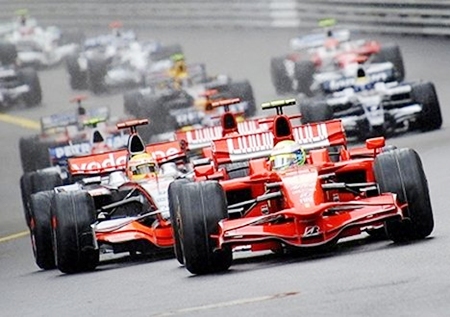For the past few years the F1 races have become processional. To try and correct this, grooved tyres were thrown out and slicks brought back – and that did nothing. Wings at the rear were made smaller, and that didn’t work. Wings at the front were raised up from track level. That did nothing as far as overtaking was concerned either.
This year three new factors were introduced – Pirelli, DRS (Drag Reduction System) and KERS (Kinetic Energy Recovery System). F1 legend Jean Alesi said, “As I see it, the biggest impact this year is clearly the tyres. Towards the end of the race things get really intense, and this is great from a fan’s perspective, creating some very exciting and unpredictable racing. One thing is for sure, the racing is really entertaining this year.”
 F1 2011
F1 2011
This year the tyre supplier has changed from Bridgestone to Pirelli, and obviously the two manufacturers were given different design parameters. Bridgestone lasted so well, and were so consistent that drivers could go an entire Grand Prix distance. In fact there was one race where the driver did the entire race, minus one lap, on the prime tyres, then popped into the pits for a change of rubber to ensure he had run on both compounds. The Pirelli tyres are quite different, with rapid wear compounds, which also hang on well for around 10 laps and then deteriorate so rapidly some drivers described the feeling like “falling off a cliff”. What this has meant is that the driver has had to think more about keeping his tyres in good shape and the strategist in the pit lane has to juggle more variables. Get them right and you have an advantage. Get them wrong and you have a driver struggling on unsuitable tyres, but not enough time to pop into the pits for a change of rubber before the race ends. (Teams are given a limited number of tyres that can be used, so the richer teams do not have the option of just throwing more and more tyres at their cars.)
The new Drag Reduction System (DRS) works by opening up the rear wing to decrease drag and downforce going down the straight. This allows a slipstreaming car a better chance of passing the lead car. This has resulted in much more passing and repassing, but the critics say this is “artificial” too. I’m sorry, it is the same for everyone, and the DRS cannot be activated if the second car is more than one second adrift of the one in front. So the answer is to stay more than one second ahead. However, I would like to see a broad yellow line on the track to show us viewers just where the DRS can be activated. It is a bit confusing at present.
The final item which has spiced up the racing is the KERS button. The energy recovered during braking is stored for use to give a 60 BHP boost when the driver pushes the button. At the start, it is sensational, launching the car past any other driver who does not have a fully charged KERS, or whose KERS is not working.
So from my spectator point of view, the three factors of tyres, DRS and KERS have made the races more entertaining. The more clever drivers and teams are working out just how to use those three factors to their advantage, just as previously drivers used to work out where and how to attack, now this has been reintroduced and has had palpable results. Like Jean Alesi, I’m all for it.




